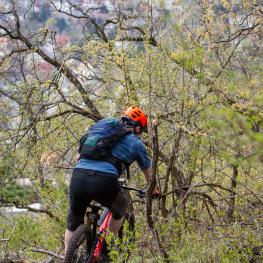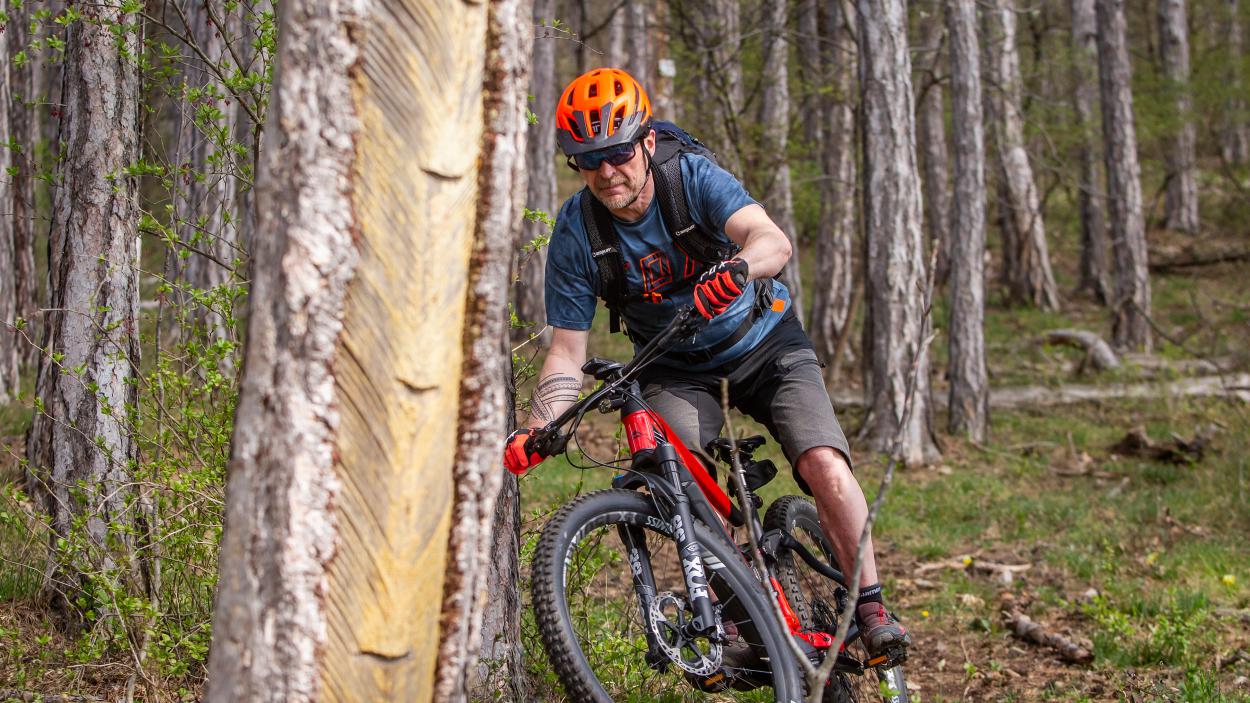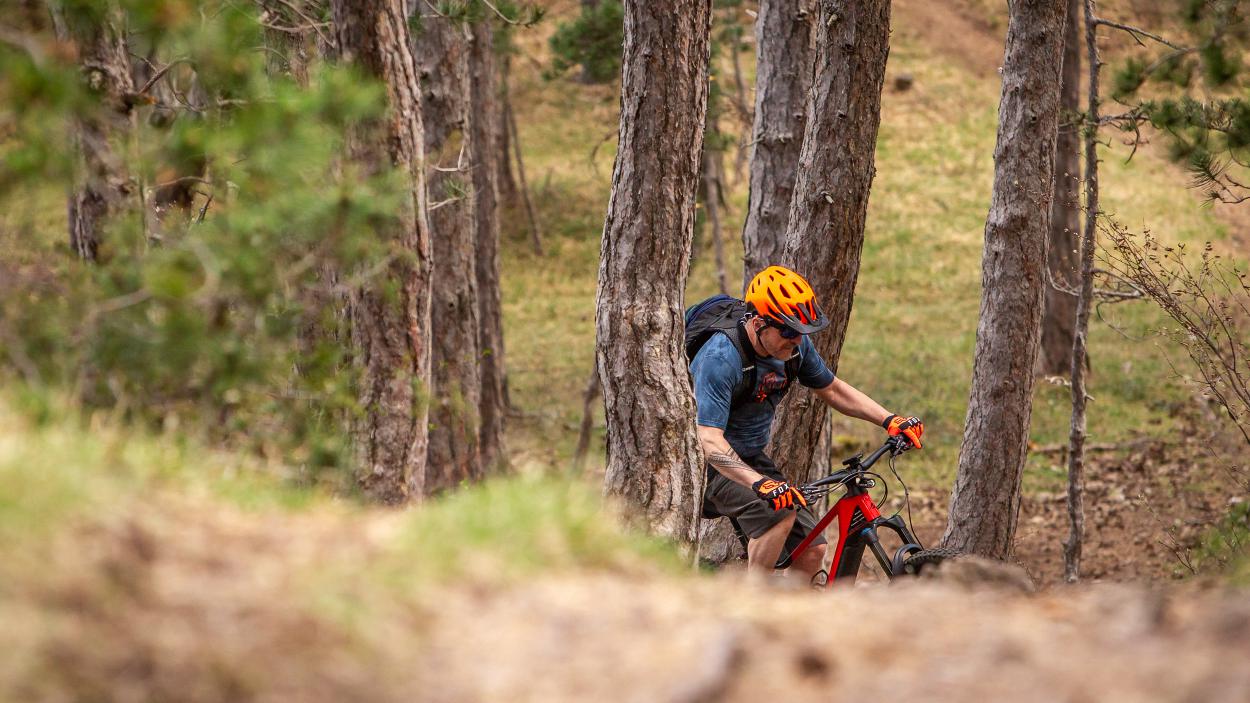
Merida eONE-Sixty 9000 long-term test
13.05.21 21:27 3562021-05-13T21:27:00+02:00Text: MOtoman (translated by Carola Felchner)Photos: Erwin HaidenAfter almost six months of riding on Merida's new e-flagship for trail fans it is time to take stock! Read on for the impressions we gained during our real-life test in winter, photographed as if it had been spring.13.05.21 21:27 3782021-05-13T21:27:00+02:00Merida eONE-Sixty 9000 long-term test
13.05.21 21:27 3782021-05-13T21:27:00+02:00 MOtoman (translated by Carola Felchner) Erwin HaidenAfter almost six months of riding on Merida's new e-flagship for trail fans it is time to take stock! Read on for the impressions we gained during our real-life test in winter, photographed as if it had been spring.13.05.21 21:27 3782021-05-13T21:27:00+02:00"There’s nothing better than a little winter biking." My thought exactly – honestly, I swear – every time I took the Merida eOne Sixty 9000 out of the garage for a ride. Be it mud, sludge, snow or ice, this e-bike makes you embrace any weather conditions!
The first thing that makes your mood rise is battery handling. Removal is as easy as re-installation. You just put the lid on and off you go – can it get any smoother? Of course, this may also turn out a disadvantage, as, after all, also unauthorised persons may remove the battery quickly without a key.
At this time of year, I'm usually out alone in the forests surrounding my hometown so that some real fast downhill riding is no problem at all.
This year, however, due to the Corona pandemic, my usually deserted home trails reminded me more of a city motorway at rush hour, especially on weekends. As I did not want to mount a bell and destroy the wonderfully clean design of the bike’s cockpit with mostly internal cable routing for electronics and lights, I continually increased the radius of my test rides to escape the crowds instead.
This way, I rode more than 600 test kilometres and gathered some insights on the Merida bike.
Taking stock
The technical facts about Merida’s eONE-Sixty have already been discussed in our showroom - click here for some detailed information.
In a nutshell, the 2021 model series’ biggest novelty is that it got specced with Shimano's EP8 motor with 630 Wh battery. The rest of the chassis, which was completely redesigned a year before (quick reminder: fully integrated battery, main frame made of carbon instead of aluminum, mullet setup, etc.), only got a slight tuning: the aforementioned innovative battery lid, new Expert eTR cockpit, front and rear lights as well as a kickstand and a mini tool, cleverly hidden underneath the saddle.
I therefore spent my winter on an e-fully specced with Fox suspension elements (Elite 38 eMTB+ fork and Float DPX2 Elite shock) providing 160 mm travel at the front and 150 mm at the rear, DT Swiss HX 1501 Spline One wheels with potent Maxxis tyres and solid Shimano components that are more than ready for trail use, a motor with plenty of torque and a generous battery range – what more could you want?
Tech Specs
| Frame | eONE-SIXTY CFA II | Handlebar | Merida Expert eTR |
| Rear Suspension | Fox Float DPX2 Elite | Stem | Merida Expert eTR II |
| Front Suspension | Fox 38 Elite eMTB+ Air | Grips | Merida Expert EC |
| Engine | Shimano EP8 | Seatpost | Merida Expert TR (XS 125 mm; S/M 150 mm; L/XL 170 mm) |
| Battery | Shimano E8036 630Wh / E8035 504Wh XS | Saddle | Merida Expert CC |
| Display | Shimano SC-EM800 | Wheels | DT Swiss Spline HX1501 ONE 30 |
| Crankset | Shimano CRE80-12-B | Tires | Maxxis Assegai 29 x 2.5"/ Maxxis Agressor 27.5 x 2.6" |
| Rear Derailleur | Shimano XT | Weight | 23,58 kg |
| Brakes | Shimano XT (4 piston) | Price | 7,799 Euro (XS: 7,599 Euro) |
| Discs | Shimano RT-MT900 / Shimano RT-EM910; 203 mm |
The bike’s looks immediately appealed to me. Its geometry is neither very edgy nor very aggressive, but thanks to the pleasant red and black paint, it looks even sleeker than it already is. You really have to look twice to recognise it as a motor-assisted fully.
Furthermore, workmanship, paintwork, individual details like the aluminum cable inlet on the main frame – aka "radiator grille" – are all of very high quality. I have no complaints, especially since the bike and its parts still look as good as new after more than 600 kilometres, with only one exception: the glue underneath the chainstay protector turned out a little feeble and needed some tape support.
Speaking of details: the small tool kit underneath the saddle does a good job.
Geometry
| Frame size | XS | S | M | L | XL |
| Wheel sizes | 29/27.5" | 29/27.5" | 29/27.5" | 29/27.5" | 29/27.5" |
| Seat tube length (mm) | 405 | 420 | 440 | 470 | 500 |
| Top tube length (mm) | 563 | 584 | 605 | 629 | 652 |
| Chain stay length (mm) | 439.5 | 439.5 | 439.5 | 439.5 | 439.5 |
| Steering angle (°) | 65.5 | 65.5 | 65.5 | 65.5 | 65.5 |
| Seat angle (°) | 75.5 | 75.5 | 75.5 | 75.5 | 75.5 |
| BB drop (mm) | 17.5 | 17.5 | 17.5 | 17.5 | 17.5 |
| Head tube length (mm) | 110 | 115 | 120 | 135 | 150 |
| Reach (mm) | 400 | 420 | 440 | 460 | 480 |
| Stack (mm) | 628.5 | 633 | 637.5 | 651.5 | 665 |
| Wheel base (mm) | 1,168 | 1,190 | 1,212 | 1,238.5 | 1,265 |
The riding position (I am 185 cm tall and tested a size L frame) is rather upright to slightly sporty due to the high front. I felt quite comfortable on the bike, especially on plains, in hilly areas, and on longer tours.
Although being a smooth and steady ride, the bike seemed very agile at the same time, which came in handy especially on narrow, winding forest paths. In general, the Merida bike is a very "easy" ride. It feels comfortable from the first moment. Especially downhill, it makes beginners feel safe without boring advanced riders – on the contrary: It is not only fun going at high speed – which it is absolutely capable of –, but also in downhill sections.
The seatpost with its 170 mm travel was more than adequate for size "L". When fully retracted, it allowed for a lot of freedom of movement downhill. If you have short legs and your body height places you between sizes M and L, however, a 470 mm seat tube plus aforementioned travel may not be the best option.
The Expert TR Dropper Post, by the way, caused one of the very few problems during this test: it refused to be pushed into the lower position twice. But after removing the battery and checking the cables, everything was fine again. I probably didn't pay enough attention to the cable routing when adjusting the saddle height and blocked the cable. A small bend or too small a radius and it may get pinched...
Sensitive powerhouse: Shimano EP8
Before we get to the heart of the new Merida eOne-Sixty, which is Shimano's EP8 motor, I’d like to say a few words about some of the features surrounding it:
Shimano’s E-Tube app (Android) is top-notch! It is easy to install, self-explanatory to use and simple to pair with the bike. Two separate riding profiles may be set up and adapted to individual needs via mobile phone. For all three support levels (Eco, Trail, Boost), maximum support in Nm can be configured, as well as the response behaviour of the motor when starting off.
I created one profile for maximum fun off-road and another profile with optimised battery drain for the longest possible range. I also made use of the option to change response behaviour when starting: the “gentle” option made for a much easier moving off in steeper terrain.
Shimano’s E-Tube Ride app (Android) however, failed to leave a lasting impression on me. Although it is nice to look at and can certainly be useful on the road or on official cycle paths, it was of no real use off-road. At the end of the day, the mobile phone display only showed the ridden linear distance, which is why I uninstalled the app after a short time.
My Garmin Edge 530 performs much better, and also displays all relevant motor and battery data such as remaining capacity and range.
Let’s get to the heart of the bike, Shimano’s EP8! I have to admit that I am more than inclined to tune in to all the praise about this new motor. Compared to its predecessor, it is not only significantly smaller (which is especially noticeable in terms of ground clearance) and lighter, but has also been improved in many other ways.
First things first: it is less noisy, and the sound is much more pleasant. On longer rides, you almost forget it is there. This was noticeable above all when riding with other e-bikers. Their bikes’ motors usually drowned out the noise of mine to an extent that it almost appeared inaudible to me.
I also consider the EP8 a game-changer in terms of the much-cited "natural riding feeling". Although competitors are catching up in this respect, riders sometimes still feel like riding on a moped. This is not the case with the new Shimano motor – which makes pedalling, especially in the newly programmed trail mode, almost feel like normal cycling.
The transition at around 25 km/h, i.e., where the motor stops to assist, is now even smoother and hardly noticeable. Since EP8 decouples itself completely from the drive shaft, exceeding the assistance limit is really fun due to the low pedalling resistance.
Shimano’s EP8 motor and the Fox suspension make the bike even better than it already was.
Merida eONE-Sixty’s two highlightsHowever, this smooth decoupling from the drive also has a downside. The EP8 clatters, especially on downhill sections and when there is no load on it. It is a known fact that Shimano’ internal drive is not the only one that clatters, and that other manufacturers also struggle with similar phenomena when the motor is at no load, which supposedly has no influence on functionality. Nevertheless, I am bugged by this constant and, at least in my perception, increasing noise when I am on tour with my Merida test bike.
Apart from that, the system works perfectly. The power, i.e., the maximum torque, which has risen to 85 Nm, seemed sufficient at all times and even more controllable thanks to the aforementioned individual programmability. SW-EM800L buttons are ergonomic and blend into the clean looks of the cockpit. They guide the rider through all three assistance levels, including walk mode, conveniently at the touch of a button. The display, mounted almost as inconspicuous as the shifting unit next to the stem, provides easy-to-read, clear information with no frills – I like.
And I was also satisfied with the range. With a primarily moderate support level (set approx. at 90% Eco, 10% Trail with max. 70 Nm) at -1°C to +5°C outside temperature and a system weight of just under 120 kg, the battery lasted for 77 kilometres and 950 metres of altitude, so that I had to ride the last 15 kilometres without support. In summer, warmer temperatures and my lower body weight would probably have allowed for a good 20 km more.
Fine parts
Still, an e-bike is only as good as the sum of its parts, which is why not only the motor, but also all other components have to be taken into consideration:
Maxxis’ Double D tyres did an impressive job. No matter whether the ground was muddy, snowy or wet: they always had enough grip, hardly ever skidded and remained responsive at any time. As this made me feel very safe, I rode a lot faster than I usually do at this time of the year. However, this was certainly not only due to the 2.6" wide rear tyre, but also to its tread and rubber compound. It’d be interesting to know how the tyres work in hot weather conditions and how much they wear off…
The Merida bike is specced with Shimano’s XT 4-piston brakes which have always been my favourites, along with XTR brakes, and again they serve bike and rider perfectly: they are easy to apply, very responsive and, if need be, powerful. Even on longer descents, the pressure point remained spot-on.
Shimano’s 1x12 XT gears were equally great to ride with. Smooth, buzz- and jerk-free; just like it is supposed to be. I found the right gear ratio for almost every riding situation, whether uphill or downhill. And if I didn’t, the high-torque motor covered it up pretty much every time.
In a nutshell: Shimano’s components were reliable partners on every single one of over 600 test kilometres.
Which brings us to what I consider the bike’s second highlight besides Shimano’s EP8: the Fox suspension! The 38 mm fork and the DPX2 shock in combination with the frame geometry and the mixed tyres – 29" at the front, 27.5" at the rear – make the eOne-Sixty even better than it has already been in recent years.
Even only roughly adjusted responsiveness was already very good. Done exactly according to the “Tuning Guide’s” specifications for air pressure, sag as well as high and low speed for rebound and compression on foxracing.com, I could not have been happier with it. Of course, depending on their personal preferences, other riders will want to adjust the settings in one direction or another with one or two clicks. For me, however, the "factory settings" were perfect: the suspension has great responsiveness, works precisely, is firm and conveys a feeling of safety.
Whether on fast trails or in tricky rocky passages: nowhere did I feel overwhelmed with this suspension.
Fazit
| Merida eONE-Sixty | |
|---|---|
| Model year: | 2021 |
| Test duration: | 5.5 cold months/600 km |
| Price: | € 7,799 SRP |
| + | Clean looks |
| + | Handling – smooth yet agile |
| + | Shimano motor |
| + | Fox suspension |
| + | Maxxis tyres |
| - | Annoying engine rattle |
| BB verdict: | E-bike for anyone and anything |
The faster you go with the eONE-Sixty, the more smoothness and stability you’ll get; and yet the bike remains highly agile, putting a smile on your face. It is this mixture of smoothness and agility that makes it an interesting option for every skill level. Whether flow trails or bike park jumps: this bike is in on it and never seems to be overchallenged. At the same time, the 2021 frame updates make it a companion suitable for everyday use on bike paths, forest roads and relaxed pub tours.
The front is a bit too heavy for my taste. I’d prefer something a little lighter and more playful – even if this means compromising on stability and good nature. But this is criticism on a high level.
Anyway, components are well chosen and harmonious, suspension does an excellent job. Not least because of this, the bike is a fun ride downhill – and due to its motor makes almost every uphill section rideable since it provides plenty of power, which remains pleasantly controllable.
With a little extra weight shifted to the front to prevent the wheel from prematurely lifting off the ground, even very steep climbs are rideable. The mullet setup with 2.6" wide rear tyre that offers sufficient grip in any riding situation certainly contributes to this, too. The Maxxis tyres are a real treasure anyway: In spite of the wintery test conditions, I can't remember a single situation of serious, uncontrollable skidding.
Basically, the EP8 provides a natural riding feel, it runs quietly, offers low pedalling resistance and switches between on and off smoothly at around 26 km/h. If you want to change EP8’s factory settings, you have a cornucopia of options thanks to the easy-to-use Shimano E-Tube app and you can also further exploit the already generous range of 630 Wh by creating an accordingly optimised profile. Only the motor noise at no load is quite annoying. But this seems to be a problem for which there is no solution (yet)...

























